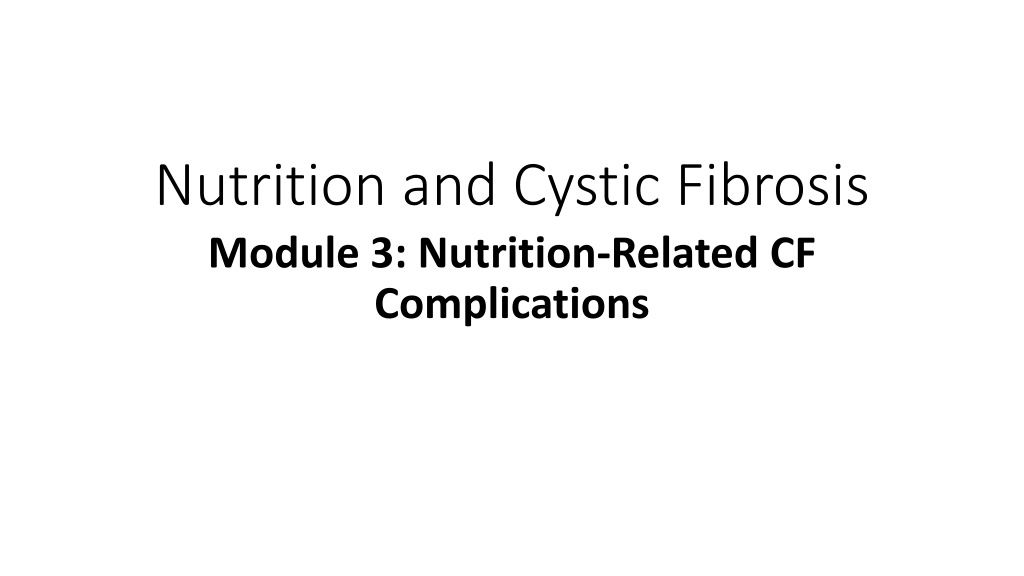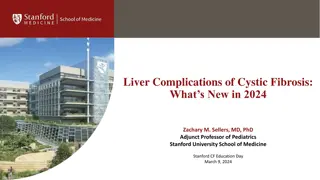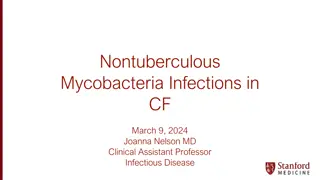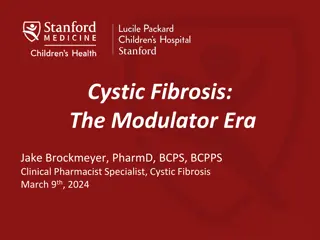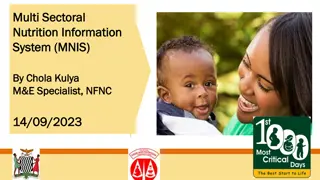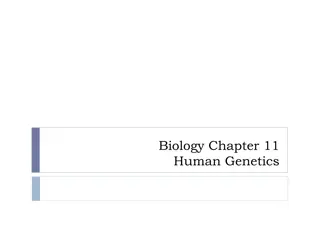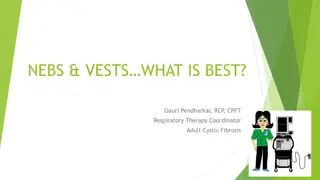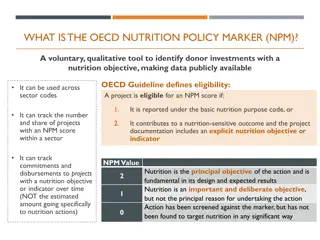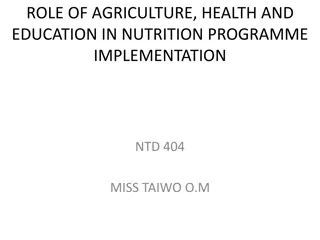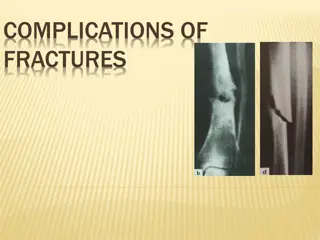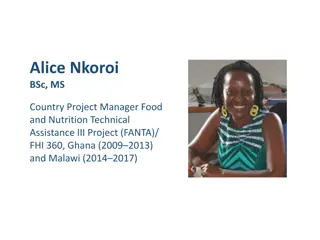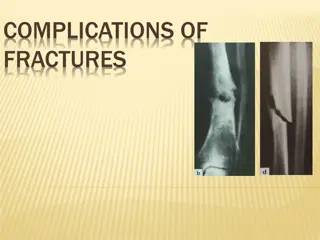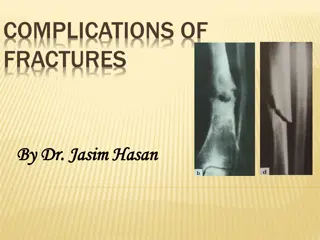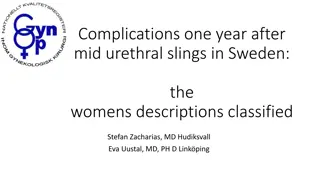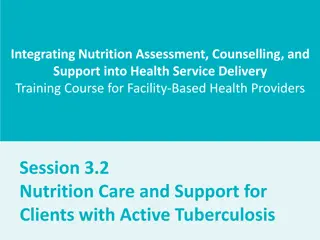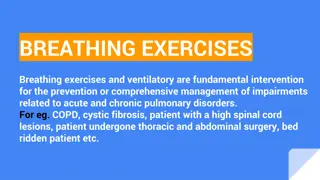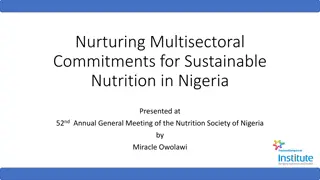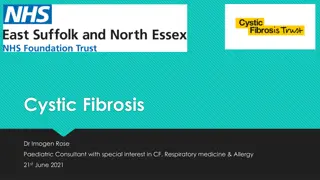Nutrition and Cystic Fibrosis: Management of CF-Related Complications
Explore the nutrition implications and management strategies for CF-related liver disease, gastrointestinal complications, and CF-related diabetes in patients. Learn about the proposed mechanisms, prevalence rates, and consequences of hepatic complications in cystic fibrosis. Gain insights into neonatal cholestasis, multilobular cirrhosis, and the nutritional challenges associated with these conditions. Culturally competent approaches to patient care are also discussed.
Uploaded on Oct 03, 2024 | 0 Views
Download Presentation

Please find below an Image/Link to download the presentation.
The content on the website is provided AS IS for your information and personal use only. It may not be sold, licensed, or shared on other websites without obtaining consent from the author. Download presentation by click this link. If you encounter any issues during the download, it is possible that the publisher has removed the file from their server.
E N D
Presentation Transcript
Nutrition and Cystic Fibrosis Module 3: Nutrition-Related CF Complications
Learning Objectives Describe the development and nutrition implications of CF-related liver disease, gastrointestinal complications, and CF related diabetes in CF patients. Discuss the nutrition management of CF-related liver disease, gastrointestinal complications, and CF related diabetes in CF patients Describe appropriate culturally competent approaches to patient care.
Nutrition-Related CF Complications Proposed Mechanism of CF-related Liver Disease CF-related liver disease GI complications CF related diabetes (CFRD) Sokol et al.
CF CF- -Related Liver Disease Related Liver Disease
CF-related Liver Disease Liver involvement common in CF patients, with 5-10% having significant disease Nutritional consequences primarily seen in neonatal cholestasis and cirrhosis Hepatic Complications in Cystic Fibrosis Type of Hepatic Complication Prevalence Rate Neonatal cholestasis Rare Hepatic steatosis 23-67% Focal biliary cirrhosis 11-72% Multilobular cirrhosis 5-10% Synthetic liver failure Rare Leeuwen et al.
Neonatal Cholestasis Liver disease with d bilirubin >2 mg/dl or >20% of total bilirubin Meconium ileus is a risk factor Normally resolves within 9 months in fat malabsorption, MCT provided for increased fat absorption Breastmilk + fortification or formula with at least 40-50% of fat as MCT * See text Table 11.2 for breastmilk fortification options Assess fat-soluble vitamin status Possible enteral nutrition support with poor growth
Multilobular Cirrhosis Median age of diagnosis = 10 yrs Portal hypertension can lead to splenomegaly, esophageal or gastric varices, and ascites Nutritional consequences Increased metabolic demand related d cardiac output Peripheral insulin resistance less efficient use of CHO for energy Osteopenia commonly seen Small bowel edema with portal hypertension which can decrease absorption With ascites, early satiety can occur leading to decreased intake Malnutrition increased metabolic demand, decreased nutrient absorption, decreased caloric intake
Cirrhosis Weight is not a reliable indicator of nutrition status due to enlarged organs and/or ascites Additional anthropometrics to monitor body composition mid-arm circumference, triceps skinfold, subscapular skinfold measures Nutrition management Energy needs based on individual nutrition status Protein 3-4 g/kg/day (restriction only with encephalopathy, but not less than 2g/kg/d) Fat 40-50% of total kcals to meet increased energy needs Carbohydrates remaining kcals, normally about 45-50% of total kcals Monitor glucose levels Smaller, frequent meals may better promote euglycemia If diet not sufficient to meet needs, consider oral supplements or supplemental TF
Cirrhosis Nutrition management, cont d Fat-soluble vitamins use standard CF supplementation Zinc need more research; consider 5 mg/kg/day oral elemental zinc supplement if deficiency suspected in pediatric patient NaCl consider 2000 mg/d restriction www.hopkinscf.org/what-is-cf/effects-of-cf/liver/
Hepatic Steatosis Also known as nonalcoholic fatty liver disease (NAFLD) Present in up to 70% of children undergoing liver biopsy for suspected liver disease Cause is typically nutrition-related Protein calorie malnutrition Protein malnutrition Essential fatty acid (EFA) deficiency related to fat malabsorption Obesity less common in CF population Bile acid deficiency Carnitine deficiency
Hepatic Steatosis Nutrition Management Malnutrition - address with nutrition interventions that increase energy, fat and protein intake EFA deficiency target is increased linoleic acid intake vegetable oils (corn, soybean, safflower), margarine; aim for >10% of total kcals Bile acid deficiency may have higher requirement for linoleic acid as with EFA deficiency Carnitine deficiency Focus on high carnitine foods such as meats, dairy, enteral TF formulas, breastmilk, and formula If deficiency confirmed through plasma carnitine testing, consider carnitine supplement of levocarnitine 50-100 mg/kg/d orally (broken into 3-4 doses over the course of a day)
GI Complications GI Complications
GI Complications GI involvement can occur in utero and in the neonate Often the first symptoms of CF to appear are GI- related Common complications Malabsorption related to pancreatic insufficiency and/or viscous secretions that interfere with nutrient absorption Gastroesophageal reflux (GERD) - most common GI issue Small intestinal bacterial overgrowth (SIBO) Distal intestinal obstruction syndrome (DIOS) Constipation GI cancers www.nhlbi.nih.gov/health/health-topics/topics/cf/signs
Gastroesophageal Reflux Leads to poor appetite and decreased energy and nutrient intake Initial therapy includes acid suppressor pill - PPI or H2 blocker Specifically for GERD symptoms Recall that PPI or H2 blocker can also be prescribed to enhance action of PERT Surgery may be indicated for severe cases laparoscopic fundoplication Nutrition management continue with high kcal, high fat diet; discontinue foods that are not tolerated on a case-by-case basis
Small Intestinal Bacterial Overgrowth (SIBO) In CF normal methods to control bacterial growth in the small intestine are disrupted Thick mucus secretions Intestinal dysmotility decreased clearance of bacteria Chronic use of antibiotics in CF population loss of good bacteria Acid suppressing medications more bacteria make it to the small intestine www.nutridesk.com.au
SIBO Treatment Broad spectrum antibiotics Bowel hydration with osmotic agent such as polyethylene glycol (Miralax) Consider probiotics which may compete with pathogenic bacteria
Distal Intestinal Obstruction Syndrome (DIOS) Complete or partial obstruction of the distal ileum with fecal material Can present in CF patients of any age Can be acute or chronic Symptoms Cramps Abdominal pain (right lower quadrant) Abdominal distension Anorexia poor appetite Weight loss Connection between nutrition and DIOS development unclear Treatment Remove obstruction with medicals or surgery (rare) Re-education regarding adherence to PERT regimen
Constipation Cause similar to those seen with DIOS Most chronically constipated CF patients have bowel movements everyday Low fiber and inadequate hydration not associated with constipation in children with CF (see text pg 186 for discussion) Treatment Laxatives - polyethylene glycol, lactulose, sorbitol Colonic stimulants senna, bisacodyl
Gastrointestinal Cancers CF patients at risk for cancers of GI tract and accessory organs Nutritional impact and management similar to those without CF Maintain adequate energy and nutrient intake, if possible Consider enteral or parenteral nutrition support depending on tissue(s) affected
CF Related Diabetes CF Related Diabetes
CF Related Diabetes (CFRD) Can occur in up to 20% of adolescents with CF, and can occur at any age Some residual insulin secretion present throughout life of CF patient MNT differs in many ways to Type 1 and Type 2 DM High kcal, high fat diet continued CFRD not associated with macrovascular complications Frequent use of oral supplements and/or enteral nutrition support necessitate individualized meal planning for euglycemia Primary treatment is insulin therapy Ketoacidosis rare Microvascular complications are of concern Regular screening of CF patients for CFRD yearly OGTT
CFRD Types of Insulin and Their Action Onset of action Duration of action Insulin Peak Nutrition management No diet restrictions continue with high kcal, high fat diet CHO counting with insulin treatment for euglycemia See text, Table 13.3 Insulin therapy Basal-bolus regimen Administered prior to meals and snacks Rapid acting Aspart 10-20 min 3-5 hr 1-2 hr Lispro 10-20 min 3-5 hr 1-2 hr Glulisine 10-20 min 3-5 hr 1-2 hr Short acting Regular 30 min 4-6 hr 2-4 hr Intermediate acting NPH 1-3 hr 8-12 hr 4-6 hr Long acting Glargine 1-2 hr 18-26 hr None Determir 1-3 hr 12-20 hr None Adapted from Nutrition in Cystic Fibrosis, Yen and Radmer Leonard, Table 13.2
References Nutrition in Cystic Fibrosis, Yen and Radmer Leonard - Chapters 11-13 Sokol et al. Recommendations for management of liver and biliary tract disease in cystic fibrosis. J Ped Gastroentrology and Nutrition. 1999;28:S1- S13. Leeuwen et al. Liver disease in cystic fibrosis. Paediatric Respiratory Reviews. 2014;15(1):69-74. Cystic Fibrosis Foundation www.cff.org Johns Hopkins Cystic Fibrosis Center - www.hopkinscf.org National Heart, Lung and Blood Institute - www.nhlbi.nih.gov Nutridesk - www.nutridesk.com.au
